| |||||||
| Search Forums |
| Advanced Search |
| Go to Page... |
 |
| Search this Thread |  1,183,505 views |
| | #1 |
| Team-BHP Support  | Combat Aircraft of the Indian Air Force The Indian Air Force has the 4th largest number of fighter aircrafts (roughly around 800) in the world. But reading about Indian Air Force in mainstream media makes for a depressing reading (it's mostly about aircraft lost due to crashes, delays in aircraft acquisition etc). So I'd like to first put my view across on these two purported IAF issues - INDIAN AIR FORCE AIRCRAFTS ARE VINTAGE True, many aircraft in IAF are 30 to 40 years old. However - 1) Most of the old aircraft have been upgraded with latest Israeli, French, Russian and Indian avionics & electronic warfare systems. Before Upgrade:  After Upgrade:  2) They are all equipped with ultra modern air-to-air missiles and laser targeting pods/guided bombs. 3) IAF pilots' flying hours per year match that of Western powers. The flying hours of pilots in our immediate neighbourhood is guesstimated to be lower. 4) Our neighbors too have the same issues as IAF. Roughly 50% of Chinese Air Force combat aircraft is of 70s/80s vintage. Eg: Chinese Air Force has around 400 Chengdu J-7, which is basically a mildly modified Mig 21. PAF has 140 Chengdu J-7s and 160 Dassault Mirage III aircraft (equivalent to Mig 21)  5) United States Air Force still uses the 60 year old Boeing B-52 Stratofortress long range bomber. They have 60 plus such planes (all have undergone upgrades) in their inventory and they intend to use the aircraft till 2040.  NUMBER OF ACTIVE AIRCRAFT IN IAF IS FALLING CONTINUOUSLY The second most favorite topic of mainstream media is the number of active squadrons in IAF. Sure, the numbers are coming down. However, there have been a few significant changes in the way Air Wars are fought these days - 1) Previously, there were 2 types of combat aircraft - air superiority aircraft (Eg: Mig 21) and Ground attack aircraft (Eg: Jaguar). Nowadays, all modern fighter aircraft are "multi-role aircraft" capable of all sorts of missions. 2) Previously, if you had to take out a fixed target (eg: radar post) 500 km inside enemy territory, you had to send aircraft in. But now, ballistic and cruise missiles can do the same job with lower risks. Modern air-to-air missiles too have longer range and better strike rate than its predecessors 20 or 30 years ago. 3) One important responsibility of Air Force is providing "Close Air Support" - striking enemy positions just a few hundred metres from the friendlies. However, in the future, the same role is likely be fulfilled by combat helicopters like HAL LCH/Boeing Apache. 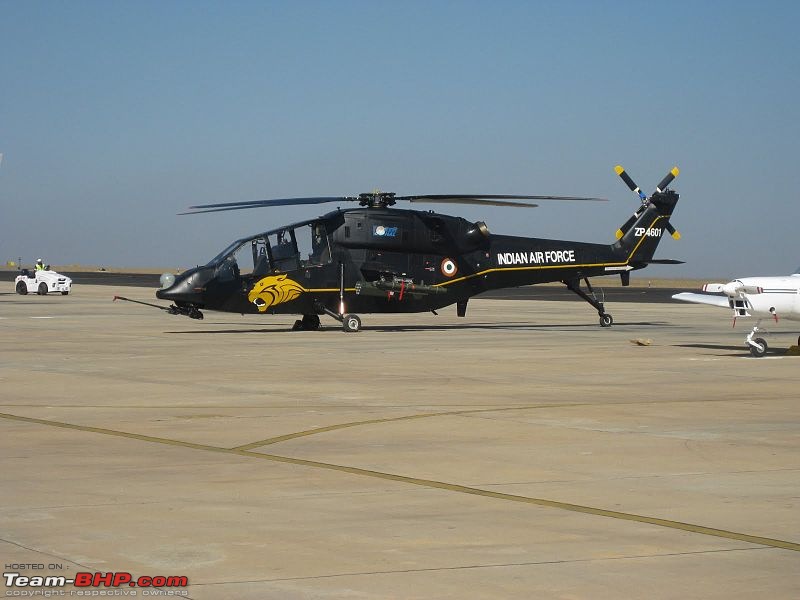 4) Acquisitions like airborne early warning aircraft and better surface to air systems (mostly from Israel & Russia) reduces the need for large numbers of fighter aircraft. AWACS & airborne tanker aircraft are actually called "force multipliers". The $5 billion deal for acquisition of S-400 surface-to-air missile defense system is another huge gamechanger. How big? The mere presence of this in Syria denied Western Air Force any ability to operate in that theater, swinging the civil war back in favor of Russians & Syrian Government. At the time of deployment, a Russian Defence Ministry official said "All illusions of amateurs about existence of invisible (stealth) jets will face a disappointing reality"  5) Older aircraft are not scrapped. They are just mothballed and kept in storage. 6) USAF had 26,000 aircraft (all types) in 1960's but now it's down to 13,000. The fall in numbers is steeper among European NATO powers and Russia. As cheaper and more effective alternatives to combat aircraft are developed, the fall in absolute numbers is expected to continue. 7) Fighter aircraft have higher attrition rate than transport and passenger aircraft world over. They are subjected to extreme supersonic maneuvers during peacetime for training. Certain African/Latin American/Middle Eastern countries don't have high attrition rates but their pilots are poorly trained. IAF believes that it is better to lose planes in peacetime rather than lose a war. PAF too trains hard and apparently, Chinese Air Force has recently adopted this philosophy. Meanwhile, if you think only IAF Migs are crashing, here is a graph of F16 crashes over time - 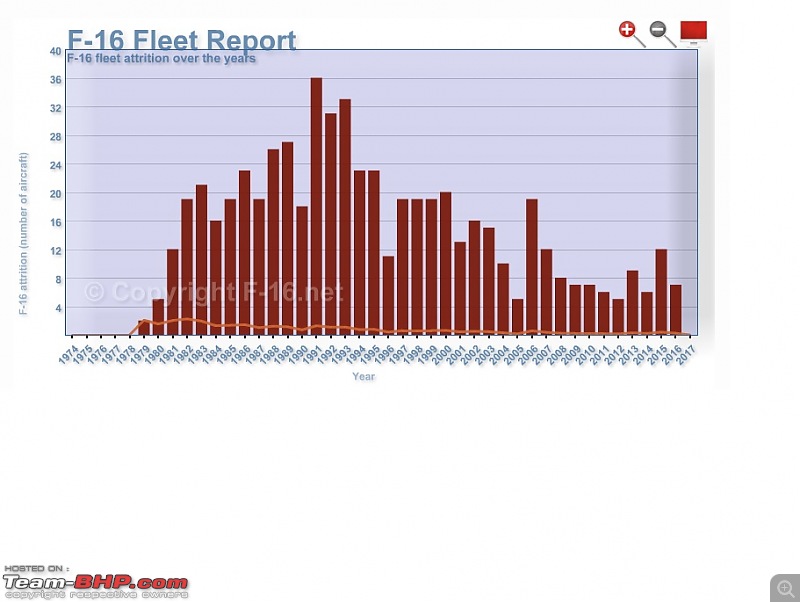 However, Russian aircrafts do have a higher crash rate per 10,000 flying hours than Western Jets. That partly explains why Russian jets are roughly 50% cheaper. After all, you get what you pay for. Anyway, in this thread, I would like to present the capabilities, performance stats and drawbacks of each of the fighter aircraft in IAF's inventory. A snapshot of current IAF aircraft -  Source: Flightglobal.com 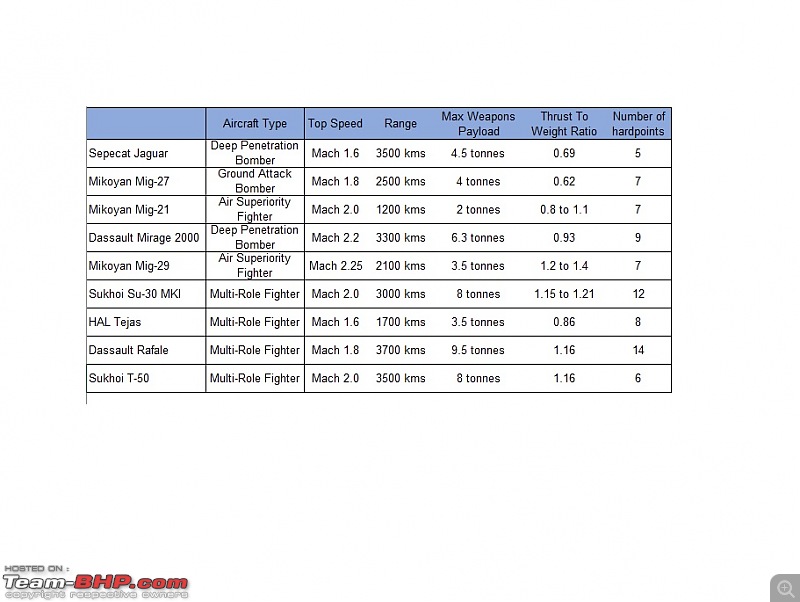 * Mach 1.0 = 1234 kmph * Range in kms on (internal fuel + drop tanks) and no weapons. Sukhoi range on internal fuel only * Number of hardpoints: Points on the fuselage & wings from which load is carried. More hardpoints means the aircraft can carry a variety of missiles, bombs, rockets and drop tanks * Max weapons payload (self-explanatory) * Thrust to weight ratio: Like power to weight ratio of cars. Air superiority fighters have thrust to weight ratio > 1.0. Such fighters can travel vertically upwards (90 degrees), a must for air-to-air dogfighting. Last edited by SmartCat : 5th March 2019 at 20:24. Reason: Typo |
| |  (81)
Thanks (81)
Thanks
 |
| The following 81 BHPians Thank SmartCat for this useful post: | .anshuman, 14000rpm, 9thsphinx, ajay0612, akshay81, anilntny, ankan.m.blr, ariesonu, Arindam_Nayek, autonarr, av8er, aveoman19, AVIS, a_bharadwaj, basubhatta, Bhalla, bj96, bsdbsd, capslock, centaur, commander, commander.sri, DetonatoR, durgesh, Flyer, Gannu_1, Gansan, GKMahajan, GTO, HammerHead, heavenlybull, HighwayHopper, highway_star, Its_Arkk, iVento, jayakumarkp, karan561, kashif_baig, keroo1099, kutts, Livnletcarsliv, LordSharan, mallumowgli, maximus., mobike008, nettooran, NiXTriX2004, nkrishnap, Omkar, ontheway, PGNarain, PM - B, Prakritij, PraNeel, prateekm, procrj, QuentinTino, Rajeevraj, rav11stars, Rehaan, rutvij, Samurai, Sangre, sayakc, ShortShifter, Slick, somjith_nair, somspaple, sri2012, sridhar-v, streetfighter, suhaas307, sups, tazmaan, theexperthand, Torque-ative, V.Narayan, vishy76, wanderernomad, wanderlust, ysjoy |
| |
| | #2 |
| Team-BHP Support  | re: Combat Aircraft of the Indian Air Force SEPECAT JAGUAR  - Sepecat Jaguar is a twin-engine deep penetration fighter bomber developed by UK/France JV (now part of British Aerospace & Dassault Systems) in the 1970's. It is primarily used for attacking ground targets but is equipped with air-to-air missiles for defence against hostile aircraft. - Ability to fly low and fast, quite literally below the radar and hence avoiding enemy air defenses. Jaguar is the platform of choice for SEAD (Suppression of Enemy Air Defence) missions and Nuclear weapons delivery. It is stable and maneuverable at low speeds (useful for bombing runs against moving targets like tanks, artillery positions, infantry etc). - Requires a short runway. Ability of take-off and land on rough landing strips (see video) Specifications: * Max speed: Mach 1.6 * Range: 3500 kms * Number of hardpoints: 5 * Max weapons load: 4.5 tonnes * Thrust to weight ratio: 0.69 - Most of the Jaguars were manufactured in India by HAL. Production was stopped in 1999. - Jaguars saw action during Kargil War. But loss of two Mig 21s to hand-held surface to air missiles meant Jaguars had to do high altitude precision bombing. The performance was not satisfactory, and the job was delegated to Dassault Mirage 2000. - Since the Kargil War, Indian Jaguars have received frequent upgrades - to the engine, display, navigation, weapons delivery and electronic warfare (Eg: jamming) systems. 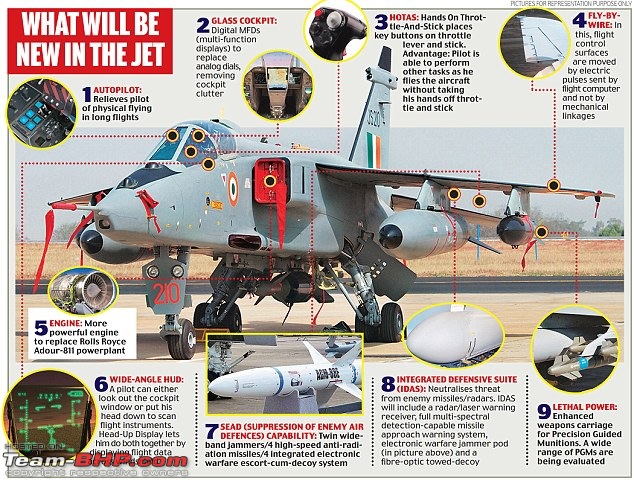 Infographic by The Tribune - Jaguar is expected to serve the IAF till the arrival of HAL AMCA (Advanced Medium Combat Aircraft) Last edited by Jaggu : 4th January 2017 at 16:43. |
| |  (37)
Thanks (37)
Thanks
 |
| The following 37 BHPians Thank SmartCat for this useful post: | 14000rpm, 9thsphinx, ariesonu, Arindam_Nayek, autonarr, av8er, Bhalla, centaur, DetonatoR, durgesh, Flyer, Gannu_1, GKMahajan, GTO, Livnletcarsliv, LordSharan, mallumowgli, maximus., moralfibre, nettooran, Omkar, pdeep4u, PraNeel, PrasunBannerjee, procrj, QuentinTino, Rajeevraj, Rehaan, sayakc, ShortShifter, Slick, somspaple, suhaas307, theexperthand, Torino, V.Narayan, ysjoy |
| | #3 |
| Team-BHP Support  | Re: Combat Aircraft of the Indian Air Force MIKOYAN MIG-27 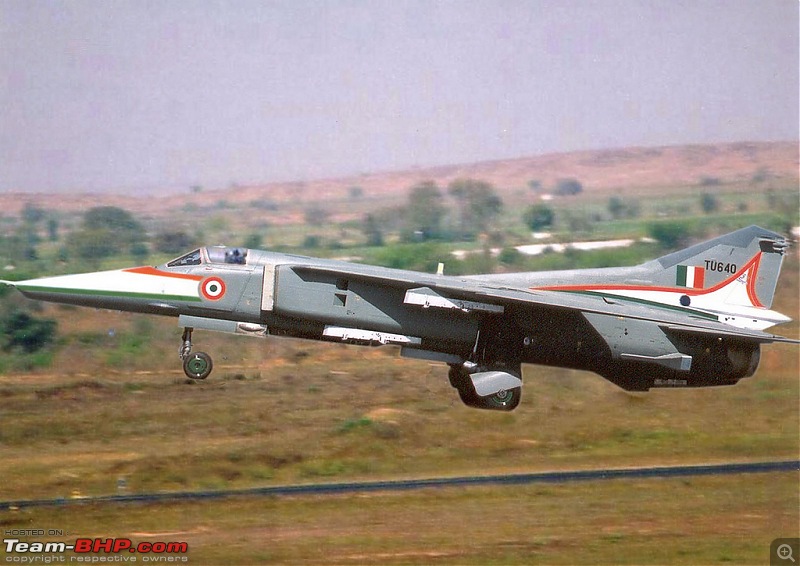 - Mikoyan Mig-27 is a single-engine fighter bomber developed in the 1980's. It is the ground attack variant of Mig-23 fighter aircraft. Like the Jaguar, Mig 27 is a "swing wing" design aircraft optimized for sub-sonic low altitude flying - Mig 27 cockpit is armoured. The only other aircraft with armoured cockpit is Sukhoi Su-25 and USAF's Fairchild A-10 Thunderbird. This protects the pilot from ground fire and hence makes the Mig 27 a good Close Air Support (bombing enemy infantry & armoured vehicles near Indian Army positions) aircraft. Like the A10 Thunderbolt, Mig 27 carries a Gatling-type rotary cannon (gun). - Unlike other fighter aircraft, the Mig 27 doesn't carry a radar. This makes it difficult for enemy aircraft to take out a Mig 27 with long range radar homing missiles. A fighter bomber like Mig 27 carries a couple of short range heat seeking missiles, but is likely to be escorted by air superiority fighters like Mig 21 in combat. Specifications: * Max speed: Mach 1.8 * Range: 2500 Kms * Thrust to weight ratio: 0.62 * Number of hardpoints: 7 * Max weapons payload: 4 tonnes - Like Jaguars, Mig 27 too was used in the initial stages of Kargil War. However, high altitude bombing runs were not satisfactory. After the war, some of the newer Mig 27s (not all) have been upgraded with modern avionics and weapons systems.  Infographic by LiveFist Upgrades include - * Radar warning receiver (RWR). Notifies the pilot if the aircraft is tracked by an enemy radar. * Multi function display & HUD * Digital Map Generator (for low altitude navigation) * Auto-pilot * Laser ranger and target market seeker (LRTMS), for dropping laser guided bombs * Identification Friend or Foe (IFF) system, for identifying friendlies (and letting friendlies know about your presence) * Israeli (ELTA) jammer & counter-measures (flares) dispensing system - And now, for the bad news. Mig 27's have had a worser crash rate than even Mig 21s. Entire fleet of Mig 27s have been grounded multiple times because of "engine flame-out" issues. The lone Mig 27 lost in Kargil War too was due to engine flame-out. A former IAF pilot leaked this video of Mig 27 crashing during take-off because of engine flame-out. Since there was no ejection, it's likely that there was a pilot fatality in this incident. - Because Mig 27 has been such a problem child in recent times, it is slowly being 'decommissioned' as newer Su 30s and Tejas roll out of HAL. Last edited by SmartCat : 3rd January 2017 at 16:53. |
| |  (35)
Thanks (35)
Thanks
 |
| The following 35 BHPians Thank SmartCat for this useful post: | 1.2TSI7DSG, 14000rpm, 9thsphinx, anandpadhye, ariesonu, Arindam_Nayek, autonarr, av8er, aveoman19, Bhalla, centaur, DetonatoR, durgesh, Gannu_1, GKMahajan, GTO, Leoshashi, Livnletcarsliv, LordSharan, mallumowgli, mi2n, mnvvishwa, nettooran, Omkar, PraNeel, procrj, redcruiser, Rehaan, shancz, ShortShifter, Slick, theexperthand, V.Narayan, vnabhi, ysjoy |
| | #4 |
| Team-BHP Support  | Re: Combat Aircraft of the Indian Air Force DASSAULT MIRAGE 2000 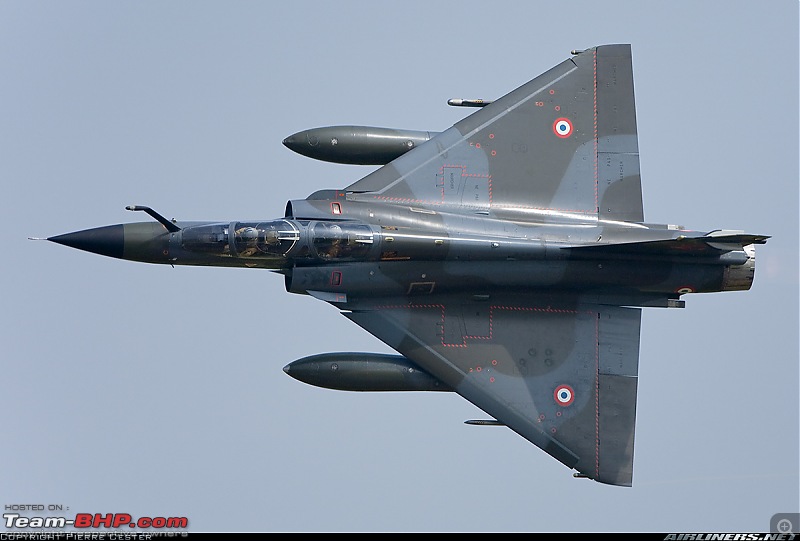 - Mirage 2000 is a 4th generation multi-role fighter aircraft developed by Dassault Aviation of France in the 1980's. It is capable of both ground attack strikes and air superiority missions. IAF has 40 single seater Mirage 2000 and 9 twin seat Mirage 2000 (which is used as a trainer aircraft, but can also be used in combat). It's a direct competitor to Lockheed Martin F16 and Mikoyan Mig 29. - Mirage 2000 has an unique 'delta wing' (triangular) design. The most obvious advantage of delta wing design is the larger surface area of the wings (for extra lift), as compared to traditional aircraft designs. Delta-wing design is also great for supersonic flights because of lowered air resistance (think bow of a ship, slicing through water). The biggest disadvantage of delta-wing design is undesirable performance (higher drag) characteristics at sub-sonic speeds. - India picked up Mirage 2000 after PAF chose F16. Although, IAF's Mirage 2000 never faced PAF's F16 directly, Greek Air Force had a dogfight with Turkish Air Force F16 in actual combat. Score 1-0 in favor of Mirage 2000 during this incident. However, it is generally accepted that F16 is slightly superior to Mirage 2000 in both air superiority and ground attack missions. F16 Fighting Falcon can carry higher payload of weapons, is more agile and has a higher thrust-to-weight than Mirage 2000. Actually, Greek Air Force operates both Mirage 2000 and F16s, and they concur with the above assessment. Specifications: * Top speed: Mach 2.2 * Range: 3300 km * Thrust to weight ratio: 0.93 (Mig 29 has thrust to weight ratio of 1.2) * Max weapons payload: 6.3 tonnes * Number of hardpoints: 9 - Looking at overall strengths and weaknesses of each IAF fighter aircraft, it's very likely that Mirage 2000 will be primarily used for ground attack, SEAD missions (attacks on enemy airbases, SAM sites, fixed radars, communication centers etc) and nuclear strikes. Mirage 2000 (along with Jaguar) being assigned the nuclear strike role essentially means that the aircraft has excellent low altitude/high speed capabilities, which is essential to dodge fixed and mobile enemy air defences. But unlike Jaguar, the Mirage 2000 can hold its own in a 1-on-1 combat with pretty much any fighter aircraft in our neighborhood. - During Kargil War, the Mirage 2000 was the fighter jet that destroyed supply lines of enemy with Israeli supplied PGMs (precision guided munitions) - flying into the battlefield at 40,000 feet to avoid hand-held Stingers. - Mirage 2000s in IAF has high serviceability of up to 80%. Just like Formula 1 cars, fighter aircrafts too need frequent servicing and maintenance after a few hours of high speed use. Serviceability of 80% means 8 out of 10 aircrafts are available for combat operations at any point of time (2 out of 10 aircrafts are sitting in the hangar for maintenance). If that sounds bad, remember that serviceability of Russian fighter aircraft in IAF (Mig21/Su30/Mig29) is between 35% (Indian Navy's Mig 29) and 75% (IAF's Mig 29). High serviceability means Mirage 2000 has high quality & reliability, low on maintenance and spare parts availability is excellent. Gentlemen, meet the Toyota Innova of IAF!  - Mirage 2000 gets the most interesting mid-life upgrade, costing up to $40 million per plane. As much as a new HAL Tejas. But this upgrade brings the Mirage 2000's capabilities pretty close to that of Rafale. Biggest leap in technology is because of a new radar and ability to fire MICA air-to-air missile.  Infographic by TOI  - IAF has purchased close to 500 MBDA MICA air-to-air missiles that gives the aircraft a big edge in air-to-air combat. Game-changing features of MICA missiles - * In air-to-air combat, there is no need turn around and point the aircraft towards the enemy flying behind. The Mirage 2000's new radar can lock onto the chasing enemy aircraft, fire the MICA missile and continue along on its original mission. * MICA Missile is equipped with Thrust Vectoring Control, just like Sukhoi Su-30MKi. The adjusting nozzles gives it excellent agility. * MICA missile is an "electronically silent" missile. When the radar homing seeker locks onto the enemy aircraft, RWR (radar warning receiver) of enemy aircraft will not warn it's pilot about the incoming MICA missile. Last edited by SmartCat : 5th March 2019 at 20:26. Reason: Minor Typo |
| |  (44)
Thanks (44)
Thanks
 |
| The following 44 BHPians Thank SmartCat for this useful post: | 1.2TSI7DSG, 14000rpm, ajay0612, anandpadhye, ariesonu, Arindam_Nayek, autonarr, av8er, aveoman19, a_bharadwaj, Bhalla, bhavik.1991, bj96, centaur, DetonatoR, download2live, durgesh, Enobarbus, Gannu_1, GKMahajan, GTO, Insearch, Livnletcarsliv, LordSharan, mallumowgli, mi2n, Mukund, nettooran, nkrishnap, Omkar, PM - B, PraNeel, PrasunBannerjee, procrj, Rehaan, rohit choudhary, shivmarwaha, sri2012, suhaas307, Teesh@BHP, theexperthand, V.Narayan, vnabhi, ysjoy |
| | #5 |
| Team-BHP Support  | Re: Combat Aircraft of the Indian Air Force MIKOYAN MIG-21  - Mig 21 is a 3rd generation air superiority fighter aircraft developed way back in the 1960's. Like Mirage 2000, the Mig 21 too is a delta-wing aircraft, but it also has tailplanes (horizontal stabilizers). Presence of horizontal stabilizers gives it extra agility during dogfights. Mig 21 has been the best selling supersonic fighter aircraft, and even now, Mig 21 constitutes roughly 10% of overall active fighter aircraft in the world. - Back in early 1970s, Western designers made a huge tactical mistake by cramming their combat aircraft with technology (radar, straight-line speed, missiles etc) and ignoring basics like dogfighting ability. Some American fighter aircraft didn't even have guns because it was considered to be obsolete. Vietnam War was a huge wake-up call for them. Inexperienced North Vietnamese with their Mig 21s took out around 100 American fighters for loss of only 50 in air-to-air combat. Mig 21s would dodge the missiles thanks to its agility, get close to American jets and blow it out of the sky. In the experienced hands of IAF, Mig 21s scored 8-1 kills against PAF during the 1971 War. IAF didn't have significant number of Mig 21s in 1971 though. - Mig 21 became a huge sales hit because of it's combat successes in the 1970's. USAF went back to basics of dogfighting & established Topgun academy, and eventually developed Lockheed Martin F16 Fighting Falcon to take on Mig 21. HAL has built around 1000 Mig 21's in the last four decades. Specifications: * Top speed: Mach 2.0 * Range: 1200 Kms * Max weapons payload: 2 tonnes * Number of hardpoints: 7 * Thrust to weight ratio: 0.8 (emergency TtW ratio of 1.1) - Although the Mig 21 is capable of carrying out air-to-ground missions, it is a poor choice for bombing campaigns because of low weapons payload. In Kargil war, IAF Mig 21's were responsible for photo-reconnaissance and providing fighter escort to Mig 27's and Jaguars. Two Mig 21's were shot down by shoulder-fired stingers. After the end of the war, a Mig 21 took out an unarmed PAF reconnaissance plane. During the war, Mig 21's flew 500 plus sorties with no malfunctions or issues. Widow-maker / Flying coffin allegations : 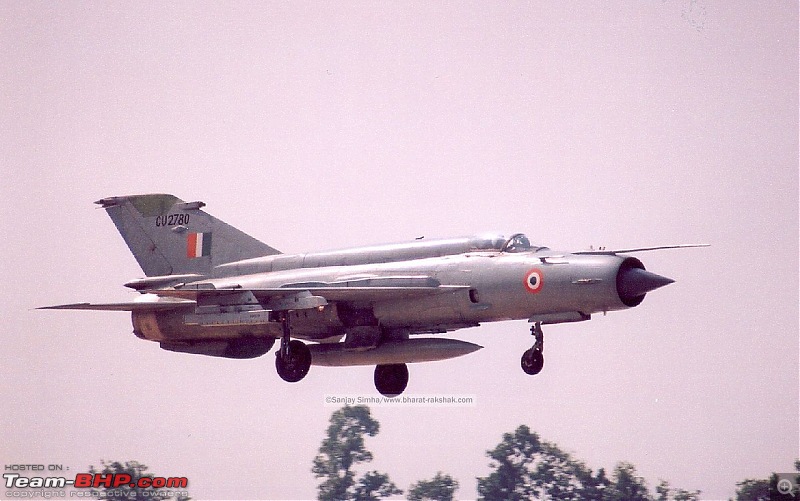 Unlike Mig 27 which has certain known problems and issues, it is now generally accepted that there is nothing specifically wrong with IAF Mig 21's (other than old airframes). * Just 10 years back, Mig 21's constituted up to 70% of active IAF aircraft. So obviously, when there are crashes, Mig 21's stand out statistically. Now, Mig 21's constitute roughly 33% of the air force and you don't hear about Mig 21 crashes as often. * The current IAF Mig 21 crash rate per flying hour is the equal to the average crash rate of all fighter aircraft in IAF. * IAF never had a proper advanced trainer aircraft (like BAe Hawk). Inexperienced pilots jumped straight from a 600 kmph HAL HJT-16 Kiran aircraft into a Mach 2.0 super-agile Mig 21. The acquisition of BAe Hawk AJT has fixed the issue. * Mig 21 has a very small wing area in comparison with its length, giving it a "cruise missile look". This gives it great agility, but very poor aerodynamic lift. To compensate for poor lift, Mig 21 take-off and landing speed is very high at 350 kmph (Su-30's is 240 kmph). This increases the probability of crashes due to pilot error/bird hits/flying stones etc. Mig 21 Upgrades: * HOTAS (Hands on throttle and stick, all major controls in the hands of the pilot) * Replacement of analogue gauges with MFDs & Heads up display * Improved navigation system & auto-pilot * Israeli electronic warfare systems (jammers). One USAF pilot in a private briefing mentioned that upgraded IAF Mig 21 was almost invisible to older F16 and F15 radars. * Improved radar that gives the Mig 21 BVR capability (Beyond Visual Range, ability to fire long range radar homing missiles) * Helmet mounted sights, gives the pilot ability to lock onto a target by "looking" at it (Apache helicopter uses similar tech) * IRST system (Infra red search & track, gives the pilot the option of switching off radar to achieve some degree of immunity from radar homing missiles. The IRST then scans the skies for heat signatures and lets the pilot know about the location of enemy aircraft) - Mig 21 will be replaced by HAL Tejas Last edited by SmartCat : 3rd January 2017 at 17:04. |
| |  (41)
Thanks (41)
Thanks
 |
| The following 41 BHPians Thank SmartCat for this useful post: | 1.2TSI7DSG, 14000rpm, 9thsphinx, AbhisheKulkarni, ajay0612, anandpadhye, arakhanna, ariesonu, Arindam_Nayek, autonarr, av8er, aveoman19, a_bharadwaj, Bhalla, centaur, DetonatoR, durgesh, Gannu_1, GKMahajan, GTO, himanshugoswami, Livnletcarsliv, LordSharan, lsjey, mallumowgli, mi2n, Omkar, PGNarain, PM - B, PraNeel, PrasunBannerjee, procrj, Rehaan, rohit choudhary, somspaple, sri2012, streetfighter, theexperthand, V.Narayan, vishy76, ysjoy |
| | #6 |
| Team-BHP Support  | Re: Combat Aircraft of the Indian Air Force MIKOYAN MIG-29 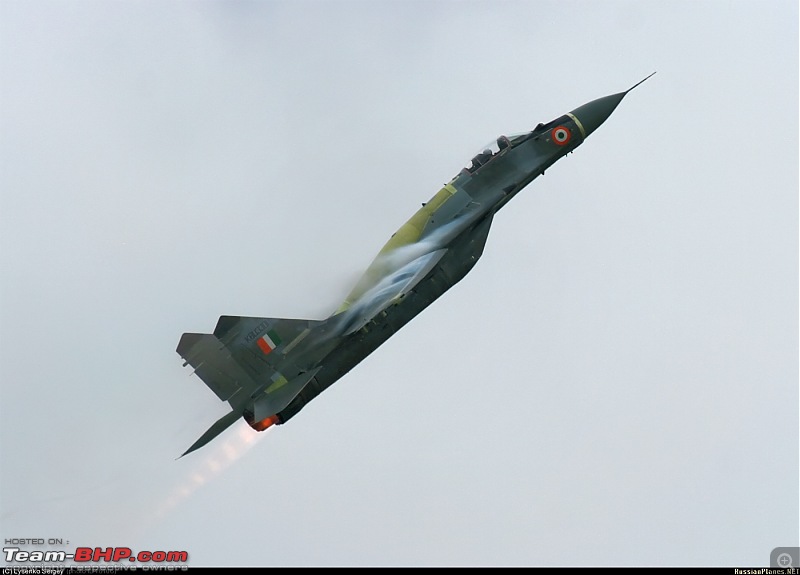 - Mig 29 is a twin-engine 4th generation air superiority fighter aircraft developed in the 1980's, and was a competitor to Lockheed Martin F16 and Dassault Mirage 2000. The design is considered to be a modern classic among fighter aircrafts, with its cobra like stance that gives the pilot an excellent view of the battlefield. India ordered Mig 29's as a response to PAF's acquisition of F16. - Mig 29 was the original 'muscle car' of fighter aircraft world, with a thrust to weight ratio of 1.2 (emergency TtW ratio of 1.4, for one minute). Mig 29 can turn faster than F16 and larger McDonnell Douglas F15 and is considered to be one of the best dogfighters of that decade. Moreover, Mig 29 was not 'all brawn and no brains'. Mig 29 was the first fighter aircraft to be equipped with helmet mounted sights mated to radar & air-to-air missile, which made dogfighting easy. The pilot could just turn his head towards the enemy aircraft to obtain target lock. - In the 1990's, Mig 29 has seen combat action in Bosnia War and the first Gulf War. And every single time, the Mig 29 was blown out of the sky when faced with F16's and F15's. This led many to disparagingly remark that modern Russian jets are good only for air shows and not actual combat. However, in both these wars, it was weak air powers (Yugoslavia & Iraq) with handful of planes facing an overwhelming (huge numbers) superpower that first destroyed radar and command/control infrastructure with cruise missiles & stealth bombers. - USAF does have huge respect for Mig 29 as a combat platform. They picked up 30 or 40 Mig 29's after unification of Germany and after the break-up of Yugoslavia. Mig 29's are still used for training purposes (marked as enemy aircraft) by USAF. Specifications: * Max speed: Mach 2.25 * Range: 2100 Kms * Thrust to weight ratio: 1.2 (1.4 on emergency boost) * Max weapons load: 3.5 tonnes (huge drawback, HAL Tejas has a higher weapons payload) * Number of hardpoints: 7 - Since Kargil War was essentially an air-to-ground war, Mig 29's have not seen air-to-air combat operations in IAF. Every Mirage 2000 on a bombing run was escorted by a couple of Mig 29's though. It has been reported that Mig 29 pilots obtained missile lock on PAF F16's (flying inside Pak territory) a couple of times. The rules of engagement forbade the pilots from taking on PAF fighter aircraft inside their territory though. - Between 1990 (after the breakup of USSR) and 2000 , parts availability for Mig 29's was a big issue. However, post-2000, the serviceability of Mig 29's in IAF has been reported to be excellent. Overall, Mig 29 has proved to be a reliable machine (with very few crashes) which encouraged the Indian Navy to order aircraft carrier variant of Mig 29. - India signed a $900 million deal with Russia to upgrade the Mig 29's. The goal was very clear - to convert the Mig 29 into a multi-role combat aircraft and improve on its shortcomings.  Upgrades: * Replacement of analogue dials with MFDs/HUDs * A new radar that can detect fighter aircraft from 120 kms, battle tank from 25 kms & building from 100 kms. * Increased fuel capacity for higher range * Increased weapons payload (4.5 tonnes) * Aerial refueling capability * Coating to reduce radar cross-section (makes it difficult to spot on radar) Last edited by SmartCat : 3rd January 2017 at 17:08. |
| |  (32)
Thanks (32)
Thanks
 |
| The following 32 BHPians Thank SmartCat for this useful post: | 1.2TSI7DSG, ajay0612, anandpadhye, Arindam_Nayek, autonarr, aveoman19, a_bharadwaj, Bhalla, centaur, DetonatoR, durgesh, Enobarbus, Gannu_1, GKMahajan, GTO, Livnletcarsliv, LordSharan, lsjey, mi2n, mnvvishwa, Omkar, PGNarain, PM - B, PraNeel, PrasunBannerjee, Rehaan, rohit choudhary, somspaple, streetfighter, theexperthand, V.Narayan, ysjoy |
| | #7 |
| Team-BHP Support  | Re: Combat Aircraft of the Indian Air Force SUKHOI SU-30MKI 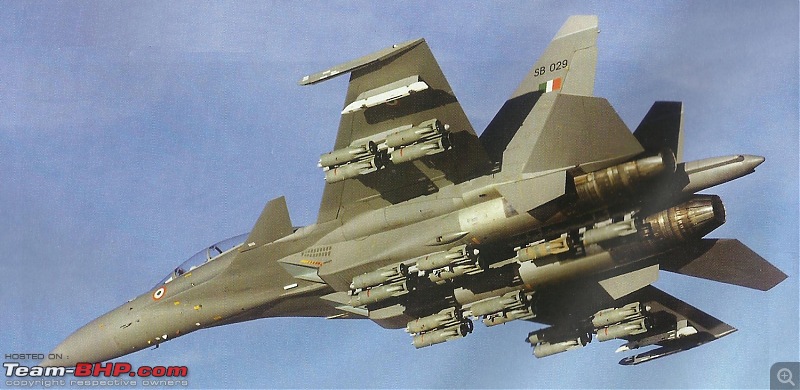 - Sukhoi Su-30 MKI is a twin-engine two seater 4.5 generation multi-role fighter aircraft developed by Russia in early 2000's. It is actually a heavily modified variant of Su-27 trainer aircraft, which was originally developed in the 1980's. Su-30 MKI is primarily an air superiority fighter aircraft, but with a large weapons payload and excellent air-to-ground attack capabilities. MKI variant is customized for IAF's requirements (there is MKM for Malaysia and MKK for China too, but are not as advanced as MKI). The pilot sits in the front and weapons systems officer at the rear. McDonnell Douglas F15 Strike Eagle is a comparable western aircraft (twin engine, two seater) - Su-30 MKI is a large heavy fighter aircraft. Su-30MKI weighs 3 times more than HAL Tejas. Since we are used to seeing passenger aircraft from a close distance, the large size of Su-30MKI is not apparent when you see it at airshows or on TV. Here is a size comparison between Su-35 (essentially a Su-30MKI) and F16  However, note that large size is not necessarily a desirable feature in a fighter aircraft. Su-30MKI is heavy on fuel consumption and maintenance, and is likely to carry out lower number of sorties than light/medium fighter aircraft. The biggest negative of Su-30MKI is the large radar cross-section of 4 sq mt and is likely to light up enemy radars from far away. In comparison, Dassault Rafale has a radar cross section of 1 sq mt (near stealthy). In close quarters combat (dogfighting), Su-30 MKI is easy to spot when compared to Mig 21 or F16. - So yes, Su-30 MKI's are not "sneaky sophisticated Art thief" type of fighter aircraft. It relies more on brute power, manoeuvrability and ability to carry large number of missiles to win battles.  Su-30 MKI gets aerodynamic aids in the form of canards and 3D thrust vectoring, and makes it a 'supermaneuverable' (aeronautical term) aircraft. It is the ability of the fighter aircraft to move in an unpredictable flight path. See video below - (Turn up the speakers, is that Rammstein playing in the background?) Canards are those little wings just behind the cockpit which provide extra lift while 3D thrust vectoring nozzles adjust the direction of jet exhaust in three dimensions. 3D Thrust vectoring aids lift and also helps it turn aggressively during dogfights. 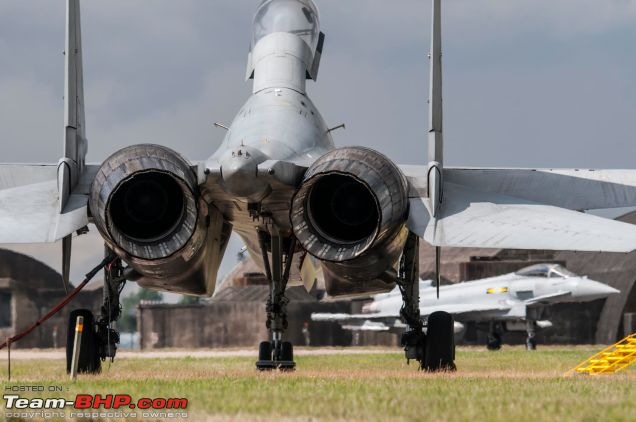 - Now obviously, Su-30 MKI has not seen combat action yet. But IAF has taken their birds for friendly simulated combat with USAF's F16 and F15, and RAF's Eurofighter Typhoon. Su-30 MKI's performed exceedingly well in air superiority missions, even against the mighty Typhoon. - However, pretty much every Western pilot or defence analyst feels fighter aircraft manoeuvres that bleeds speed and makes aircraft nearly stationary (like Pugachev's Cobra) is suicidal in real-life combat situations. Because as soon as the attacking aircraft sees a near stationary Su-30 MKI ahead, he is likely to pull up hard, get back down and take out the aircraft from top. Something like this - 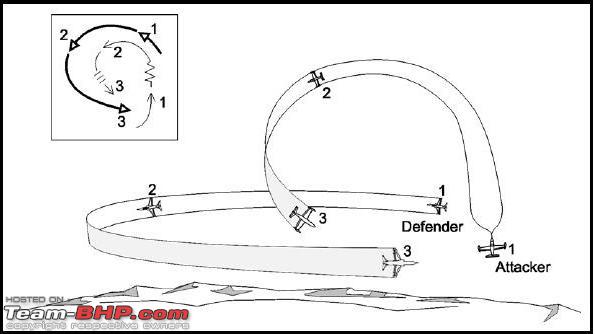 Remember that once Su-30 MKI is near stationary, it is difficult to aim the aircraft towards the sky and accelerate. Specifications: Top Speed: Mach 2.0 Range: 3000 kms Max Weapons Payload: 8 tonnes Thrust to Weight Ratio: 1.15 (emergency 1.21) Number of hardpoints: 12 45 minute documentary on IAF's Su-30 MKI on Times Now - Serviceability Issues: IAF Su-30 MKI has a poor serviceability of 60%. That is, out of 100 aircraft, only 60 are available for combat at any point of time. The remaining 40 aircraft are sitting in the hangar awaiting repairs/maintenance. However, this is just a supply chain issue, and IAF expects the serviceability of Su-30 MKI to go up to 75% over time. Upgrades: * Ability to carry Brahmos cruise missile. This gives the Su-30 MKI stand-off capability for taking out enemy airfields and radar stations from a safe distance. * AESA Radar (Active Electronically Scanned Array Radar). These radars do not have that ubiquitous rotating emitter. They are "electronically silent" - that is, they do not alert the enemy aircraft's "radar warning receiver". Plus, Su-30 MKI's AESA radar can track up to 30 enemy aircraft in the vicinity, classify 6 such aircraft as immediate threats and engage them with missiles. * Radar absorbent materials coating to reduce the radar cross section Last edited by SmartCat : 3rd January 2017 at 19:33. |
| |  (119)
Thanks (119)
Thanks
 |
| The following 119 BHPians Thank SmartCat for this useful post: | 1.2TSI7DSG, 2W-4W, 9thsphinx, a*ed, ajay0612, AlphaKilo, amitkb, amitpunjani, amit_snk, anilntny, ankan.m.blr, arakhanna, Arindam_Nayek, autonarr, av8er, aveoman19, a_bharadwaj, Beerus, Bhalla, bj96, bullock-Car, centaur, Dennis, desiaztec, DetonatoR, DevilzzzzOwn, dhanushmenon, Divya Sharan, DoneAndDusted, DriveTrain, durgesh, Enobarbus, FASTLIFE, FlyingSpur, for_cars1, free_will, Gannu_1, girishglg, GJ01, GKMahajan, greenwolf08, GTO, HammerHead, Hirohito, i74js, indian21r, Insearch, iron, Ironhide, jalsa777, jayakumarkp, kashif_baig, Kool_Kid, krish3, ksameer1234, Lalvaz, lancer_rit, Latheesh, Livnletcarsliv, Lobogris, LoneRidder, LordSharan, lsjey, mac187, mallumowgli, manas_270, mazda4life, MercFan, mnvvishwa, mpksuhas, nettooran, nishchal316, Omkar, PAkshay, peterjim13, PM - B, Prakritij, PraNeel, PrasunBannerjee, procrj, pvbengaluru, Rajeevraj, rajess_in, redcruiser, Rehaan, RoadSurfer, rohit choudhary, rohitoasis, rxpaul, Sail, sandhyab, sandsun7, SDP, shancz, shipnil, Shreyans_Jain, skanchan95, somjith_nair, somspaple, Starscream1188, Sting, streetfighter, su1978, supertinu, suyr, Teesh@BHP, The Rationalist, theexperthand, thewhiteknight, Torino, V.Narayan, v12, Venkatesh.C, vnabhi, Whiplash7, wrongturn, XUVwanderer, ysjoy, Zinda |
| | #8 |
| Team-BHP Support  | Re: Combat Aircraft of the Indian Air Force Thread moved out from the Assembly Line. Thanks for sharing! |
| |  (1)
Thanks (1)
Thanks
 |
| The following BHPian Thanks GTO for this useful post: | aviat18 |
| | #9 |
| BHPian Join Date: Nov 2015 Location: MH01/TS09
Posts: 695
Thanked: 1,759 Times
| Re: Combat Aircraft of the Indian Air Force Jaw dropping thread! Literally salivating at the end of reading this! Amazing info and superb analysis! |
| |  (2)
Thanks (2)
Thanks
 |
| The following 2 BHPians Thank 1.2TSI7DSG for this useful post: | ShortShifter, SmartCat |
| | #10 |
| BHPian Join Date: Apr 2009 Location: London
Posts: 621
Thanked: 1,010 Times
| Re: Combat Aircraft of the Indian Air Force Brilliant !!! Brilliant !!! Very well written. Its so easy to understand due to the way it has been composed.  Is that all?? what about Tejas, Rafale, Rudra, T50 etc. I know they have not entered the service but would love to know about them Thanks |
| |  (1)
Thanks (1)
Thanks
 |
| The following BHPian Thanks chandrda for this useful post: | SmartCat |
| | #11 |
| BHPian Join Date: Jan 2016 Location: Hyderabad
Posts: 246
Thanked: 781 Times
| Re: Combat Aircraft of the Indian Air Force Thanks a lot Smartcat. The information is well researched and insightful. The serviceability percentage sounds low, but it has actually improved compared to the times before I retired from the IAF 12 years ago. The internal supply chain was inefficient and cumbersome at that time. I remember how difficult it was to get spares when I worked in a major transport squadron. Cannibalization was rampant. If an aircraft is down for some reason, it was turned into a "Christmas tree". Its parts were cannibalized to make other aircraft serviceable. This was done to make sure that the AOG demands (Aircraft on ground, similar to Vehicle off Road demands for spares raised by car service centres) are restricted to a minimum number of aircraft. The downside of this practice is that components used to fly in multiple aircrafts in the time between overhauls. Component life tracking was done manually, hence it was inefficient. There were many cases of components flying beyond their overhaul lives, thereby severely compromising flight safety. I had the honour to be the last man posted out from the operating strength of a medium haul transport aircraft when the fleet was grounded for good. I was involved in the scrapping process of all spares and equipment belonging to that aircraft. Shockingly, a large number of components that were termed unavailable during the flying days of the aircraft were actually available in the warehouses. Things were that bad. These inefficiencies lead to severe stress on the maintenance personnel, low serviceability percentage and mediocre flight safety performance. Another aspect is the accessibility to maintenance related information which was not very good. Dependence on specific individuals for specific maintenance tasks was common in the squadrons and knowledge transfer was not always optimal. Despite all this The IAF had outstanding mission success rates; it is a tribute to the men and machines that guard our skies. A lot of all that has changed now and things are constantly improving. I keep meeting some of my friends who are still in service and some youngsters with whom I made acquaintance after I retired. There is a world of difference in the way the IAF operates these days. We can rest assured that the safety of our skies is in good hands. |
| |  (26)
Thanks (26)
Thanks
 |
| The following 26 BHPians Thank Enobarbus for this useful post: | 14000rpm, aabhimanyu04, Abhi_abarth, Arindam_Nayek, chennai-indian, DetonatoR, FORTified, GoBlue, himanshugoswami, iron, Lobogris, mallumowgli, mpksuhas, NetfreakBombay, nettooran, NiInJa, PM - B, Prakritij, SmartCat, somspaple, sri2012, Sting, Turbokick, V.Narayan, vivtho, ysjoy |
| |
| | #12 |
| BHPian Join Date: Oct 2012 Location: Pune
Posts: 162
Thanked: 660 Times
| Re: Combat Aircraft of the Indian Air Force Mind blowing thread. Never knew details so intricately.  However, would like to know more about Tejas, as it is matter of pride to have a Made in India combat aircraft.  |
| |  (1)
Thanks (1)
Thanks
 |
| The following BHPian Thanks speedguy for this useful post: | SmartCat |
| | #13 |
| BHPian | Re: Combat Aircraft of the Indian Air Force A very interesting read. Thanks for compiling all the info! A thought occurred to me. If there are just 800 fighter jets in the country, most of the (lakhs of) kids dreaming of flying fighter jets for the country are going to be pretty disappointed.  The flipside is that the air force will benefit from the larger applicant pool by being more selective and getting better raw talent. The flipside is that the air force will benefit from the larger applicant pool by being more selective and getting better raw talent.I may be wrong about how it works in the IAF, but I'm guessing the competition within the force to get to fly a Sukhoi must be super tough! Last edited by Tanmay K : 4th January 2017 at 11:26. |
| |  (1)
Thanks (1)
Thanks
 |
| The following BHPian Thanks Tanmay K for this useful post: | SmartCat |
| | #14 | ||
| BHPian Join Date: Oct 2013 Location: KA21
Posts: 509
Thanked: 1,616 Times
| Re: Combat Aircraft of the Indian Air Force Thanks for sharing the detailed report!!. Quote:
Indian Jaguars are currently being upgraded to DARINIII standards which includes upgraded avionics suite and also it is being considered to upgrade the current engines with Honeywell F125IN. Quote:
During Kargil war, we have lost MiG27 piloted by Flt.Lt. Nachiketa due to engine failure and Mig21 piloted by Sqn Ldr Ajay Ahuja and rest is history. Last edited by DragonHawk : 4th January 2017 at 11:45. | ||
| |  (10)
Thanks (10)
Thanks
 |
| The following 10 BHPians Thank DragonHawk for this useful post: | aveoman19, chennai-indian, Foxbat, Lalvaz, Livnletcarsliv, mallumowgli, PM - B, SmartCat, vivtho, WheelNut |
| | #15 |
| BHPian Join Date: May 2009 Location: --
Posts: 897
Thanked: 1,169 Times
| Re: Combat Aircraft of the Indian Air Force Thanks a lot Smartcat. Lovely thread indeed!!! Have always been in awe of these machines and this thread is a feast to read for me. While I understand each of these has their own +ves and -ves but on the whole, would you know which one can be considered the best with optimum trade offs between different capabilities and offering a wholesome pack? |
| |  (1)
Thanks (1)
Thanks
 |
| The following BHPian Thanks centaur for this useful post: | SmartCat |
 |


